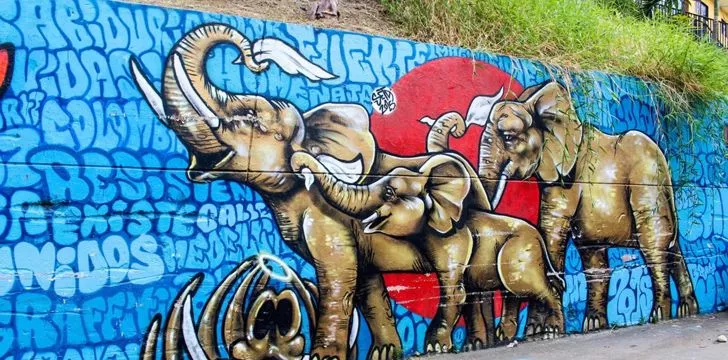No matter how rich or poor a city is, there is often some trace of graffiti somewhere.
It’s so common, sometimes you don’t even notice it anymore!
But did you ever stop to think about the history of graffiti or different styles?
Check out these 21 facts about this worldwide movement!
An estimated $1-$3 is spent per year by each taxpayer to remove graffiti.
The word graffiti originates from both Greek and Italian – the Greek word “graphein” which means “to write,” and the Italian word “graffito,” which means “a scratch.”
Los Angeles cleans over 30 million square feet of graffiti per year.
Many graffiti artists remain anonymous to protect their identity and reputation, as well as avoid legal consequences.
Graffiti, as it’s known today, started in Philadelphia in the late 1960s. Originally, graffiti was mainly used to make political statements and mark gang territory rather than to provide artistic value.
There are many different forms of tagging, one called “pissing,” in which one refills a fire extinguisher with paint which allows for tags as high as 20 feet. Because it is such a difficult style, the outcome is usually wavy and sloppy.
Most graffiti artists wish to be called “writers” and accompany their work with a unique signature called a “tag.” This is especially true for graffiti artists who want public recognition.
In modern times, the most commonly used graffiti materials is spray paint and marker pens.
Banksy is the most popular graffiti artist, known for his stencil art with political and anti-war themes. They remain anonymous and are based in Bristol, England, but their work can be seen worldwide.
The world record for the longest graffiti scroll is 7,366 feet and 9 inches. It was done in Dubai in 2014 by over 100 artists and contained scenes of history for the United Arab Emirates in celebration for their 43rd United Arab Emirates Union Day.
While graffiti is mostly illegal wherever you go, there are about 1,650 legal graffiti walls around the world.
“Yarn Bombing” is technically a form of graffiti that originated in Texas. It consists of covering objects, structures, or trees with decorative knitted or crocheted material.
The first known example of “modern style” graffiti is found in the ancient Greek city of Ephesus. The graffiti shows a handprint that somewhat resembles a heart, along with a footprint and a number. It is thought that this indicated that a brothel was nearby.
A “Heaven spot” is a piece of graffiti done in an area that’s hard to reach, such as a rooftop or overpass. The name has a double meaning – one because it’s so high up that it’s towards the “heavens.” The other meaning refers to the fact that it is often a serious challenge in a dangerous location, and in case of an accident, the artist could die and “go to heaven.”
Graffiti writers have what’s called a “black book,” which is a sketchbook where they draw and plan out prospective graffiti artwork. Writers use their black books to fine-tune their style and retain any ideas they may have for potential future use as a graffiti piece.
Graffiti used to be a term used to refer to inscriptions and figure drawings found on the walls of ancient ruins, like Pompeii or the Roman Catacombs. The eruption of Mount Vesuvius preserved the graffiti in Pompeii.
The earliest forms of graffiti were found in ancient Roman architecture as images carved onto walls.
The first known graffiti artist was Mr. Darryl McCray, street named Cornbread. In the late 1960s, he and a group of friends started tagging their nicknames on walls around Philadelphia, which instigated the modern graffiti movement.
Graffiti bombing is when a large graffiti piece is put up over a short period of time. Train bombing is one common form where a group of writers will quickly cover a train in graffiti before the authorities arrive.
There is a difference between graffiti and street art. In graffiti, the writers are generally not interested in the public understanding their work; instead, they use it to speak to other writers. Street art is used to engage everyone.
People who are new to graffiti are called toys. Those with more experience and respect among other writers are called kings or queens.

















